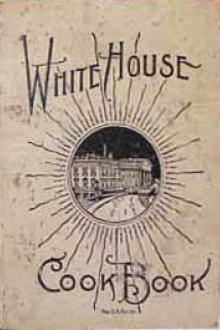The Whitehouse Cookbook (1887), Hugo Ziemann [world of reading .TXT] 📗

- Author: Hugo Ziemann
- Performer: -
Book online «The Whitehouse Cookbook (1887), Hugo Ziemann [world of reading .TXT] 📗». Author Hugo Ziemann
PRESERVED STRAWBERRIES.
For every pound of fruit weigh a pound of refined sugar; put them with the sugar over the fire in a porcelain kettle, bring to a boil slowly about twenty minutes. Take them out carefully with a perforated skimmer and fill your hot jars nearly full; boil the juice a few minutes longer and fill up the jars; seal them hot. Keep in a cool, dry place.
TO PRESERVE BERRIES WHOLE. (Excellent.)
Buy the fruit when not too ripe, pick over immediately, wash if absolutely necessary and put in glass jars, filling each one about two-thirds full.
Put in the preserving kettle a pound of sugar and one cupful of water for every two pounds of fruit, and let it come slowly to a boil. Pour this syrup into the jars over the berries, filling them up to the brim; then set the jars in a pot of cold water on the stove, and let the water boil and the fruit become scalding hot. Now take them out and seal perfectly tight. If this process is followed thoroughly, the fruit will keep for several years.
PRESERVED EGG PLUMS.
Use a pound of sugar for a pound of plums; wash the plums and wipe dry; put the sugar on a slow fire in the preserving kettle, with as much water as will melt the sugar and let it simmer slowly; then prick each plum thoroughly with a needle, or a fork with fine prongs, and place a layer of them in the syrup; let them cook until they lose their color a little and the skins begin to break; then lift them out with a perforated skimmer and place them singly in a large dish to cool; then put another layer of plums in the syrup and let them cook and cool in the same manner, until the whole are done; as they cool, carefully replace the broken skins so as not to spoil the appearance of the plums; when the last layer is finished, return the first to the kettle, and boil until transparent; do the same with each layer; while the latest cooked are cooling, place the first in glass jars; when all are done, pour the hot syrup over them; when they are cold, close as usual; the jelly should be of the color and consistency of rich wine jelly.
PRESERVED PEACHES.
Peaches for preserving may be ripe but not soft; cut them in halves, take out the stones and pare them neatly; take as many pounds of white sugar as of fruit, put to each pound of sugar a teacupful of water; stir it until it is dissolved; set it over a moderate fire; when it is boiling hot, put in the peaches; let them boil gently until a pure, clear, uniform color; turn those at the bottom to the top carefully with a skimmer several times; do not hurry them. When they are clear, take each half up with a spoon and spread them on flat dishes to become cold. When all are done, let the syrup boil until it is quite thick; pour it into a large pitcher and let it set to cool and settle. When the peaches are cold put them carefully into jars and pour the syrup over them, leaving any sediment which has settled at the bottom, or strain the syrup. Some of the kernels from the peach-stones may be put in with the peaches while boiling. Let them remain open one night, then cover.
In like manner quince, plum, apricot, apple, cherry, greengage and other fruit preserves are made; in every case fine large fruit should be taken, free from imperfections, and the slightest bruises or other fault should be removed.
PRESERVED GREEN TOMATOES.
Take one peck of green tomatoes. Slice six fresh lemons without removing the skins, but taking out the seeds; put to this quantity six pounds of sugar, common white, and boil until transparent and the syrup thick. Ginger root may be added, if liked.
PRESERVED APPLES. (Whole.)
Peel and core large firm apples (pippins are best). Throw them into water as you pare them. Boil the parings in water for fifteen minutes, allowing a pint to one pound of fruit. Then strain and, adding three-quarters of a pound of sugar to each pint of water, as measured at first, with enough lemon peel, orange peel or mace, to impart a pleasant flavor, return to the kettle. When the syrup has been well skimmed and is clear, pour it boiling hot over the apples, which must be drained from the water in which they have hitherto stood. Let them remain in the syrup until both are perfectly cold. Then, covering closely, let them simmer over a slow fire until transparent. When all the minutiæ of these directions are attended to, the fruit will remain unbroken and present a beautiful and inviting appearance.
PRESERVED QUINCES.
Pare, core and quarter your fruit, then weigh it and allow an equal quantity of white sugar. Take the parings and cores and put in a preserving kettle; cover them with water and boil for half an hour; then strain through a hair-sieve, and put the juice back into the kettle and boil the quinces in it a little at a time until they are tender; lift out as they are done with a drainer and lay on a dish; if the liquid seems scarce add more water. When all are cooked, throw into this liquor the sugar, and allow it to boil ten minutes before putting in the quinces; let them boil until they change color, say one hour and a quarter, on a slow fire; while they are boiling occasionally slip a silver spoon under them to see that they do not burn, but on no account stir them. Have two fresh lemons cut in thin slices, and when the fruit is being put in jars lay a slice or two in each. Quinces may be steamed until tender.
PRESERVED PEARS.
One pound of fruit, one pound of sugar; pare off the peeling thin. Make a nice syrup of nearly one cupful of water and one pound of sugar, and when clarified by boiling and skimming put in the pears and stew gently until clear. Choose rather pears like the Seckle for preserving, both on account of the flavor and size. A nice way is to stick a clove in the blossom end of each pear, for this fruit seems to require some extraneous flavor to bring out its own piquancy. Another acceptable addition to pear preserves may be found instead, by adding the juice and thinly pared rind of one lemon to each five pounds of fruit. If the pears are hard and tough, parboil them until tender before beginning to preserve, and from the same water take what you need for making their syrup.
If you can procure only large pears to preserve, cut them into halves, or even slices, so that they can get done more quickly, and lose nothing in appearance, either.
PINEAPPLE PRESERVES.
Twist off the top and bottom and pare off the rough outside of pineapples; then weigh them and cut them in slices, chips or quarters, or cut them in four or six and shape each piece like a whole pineapple; to each pound of fruit, put a teacupful of water; put it in a preserving kettle, cover it and set it over the fire and let them boil gently until they are tender and clear; then take them from the water, by sticking a fork in the centre of each slice, or with a skimmer, into a dish.
Put to the water white sugar, a pound for each pound of fruit; stir it until it is all dissolved; then put in the pineapple, cover the kettle and boil them gently until transparent throughout; when it is so, take it out, let it cool and put it in glass jars; let the syrup boil or simmer gently until it is thick and rich and when nearly cool, pour it over the fruit. The next day secure the jars, as before directed.
Pineapple done in this way is a beautiful and delicious preserve. The usual manner of preserving it by putting it into the syrup without first boiling it, makes it little better than sweetened leather.
TO PRESERVE WATERMELON RIND AND CITRON.
Pare off the green skin, cut the watermelon rind into pieces. Weigh the pieces and allow to each pound a pound and a half of loaf sugar. Line your kettle with green vine-leaves, and put in the pieces without the sugar. A layer of vine-leaves must cover each layer of melon rind. Pour in water to cover the whole and place a thick cloth over the kettle. Simmer the fruit for two hours, after scattering a few bits of alum amongst it. Spread the melon rind on a dish to cool. Melt the sugar, using a pint of water to a pound and a half of sugar, and mix with it some beaten white of egg. Boil and skim the sugar. When quite clear, put in the rind and let it boil two hours; take out the rind, boil the syrup again, pour it over the rind, and let it remain all night. The next morning, boil the syrup with lemon juice, allowing one lemon to a quart of syrup. When it is thick enough to hang in a drop from the point of a spoon, it is done. Put the rind in jars and pour over it the syrup. It is not fit for use immediately.
Citrons may be preserved in the same manner, first paring off the outer skin and cutting them into quarters. Also green limes.
TO PRESERVE AND DRY GREENGAGES.
To every pound of sugar allow one pound of fruit, one quarter pint of water.
For this purpose, the fruit must be used before it is quite ripe and part of the stalk must be left on. Weigh the fruit, rejecting all that is in the least degree blemished, and put it into a lined saucepan with the sugar and water, which should have been previously boiled together to a rich syrup. Boil the fruit in this for ten minutes, remove it from the fire, and drain the greengages. The next day boil up the syrup and put in the fruit again, let it simmer for three minutes, and drain the syrup away. Continue this process for five or six days, and the last time place the greengages, when drained, on a hair-sieve, and put them in an oven or warm spot to dry; keep them in a box, with paper between each layer, in a place free from damp.
PRESERVED PUMPKINS.
To each pound of pumpkin allow one pound of roughly pounded loaf sugar, one gill of lemon juice.
Obtain a good, sweet pumpkin; halve it, take out the seeds and pare off the rind; cut it into neat slices. Weigh the pumpkin, put the slices in a pan or deep dish in layers, with the sugar sprinkled between them; pour the lemon juice over the top, and let the whole remain for two or three days. Boil all together, adding half a pint of water to every three pounds of sugar used until the pumpkin becomes tender; then turn the whole into a pan, where let it remain for a week; then drain off the syrup, boil it until it is quite thick, skim, and pour it boiling over the pumpkin. A little bruised ginger and lemon rind, thinly





Comments (0)